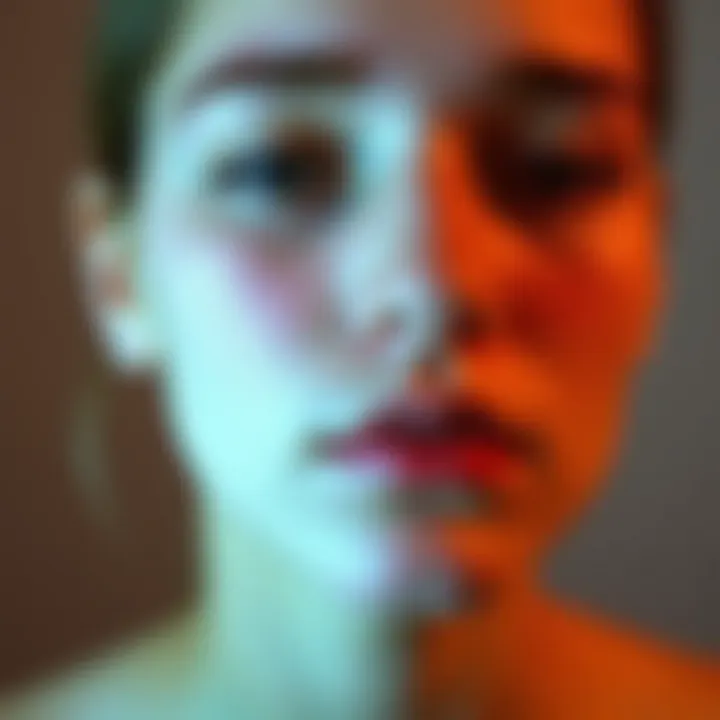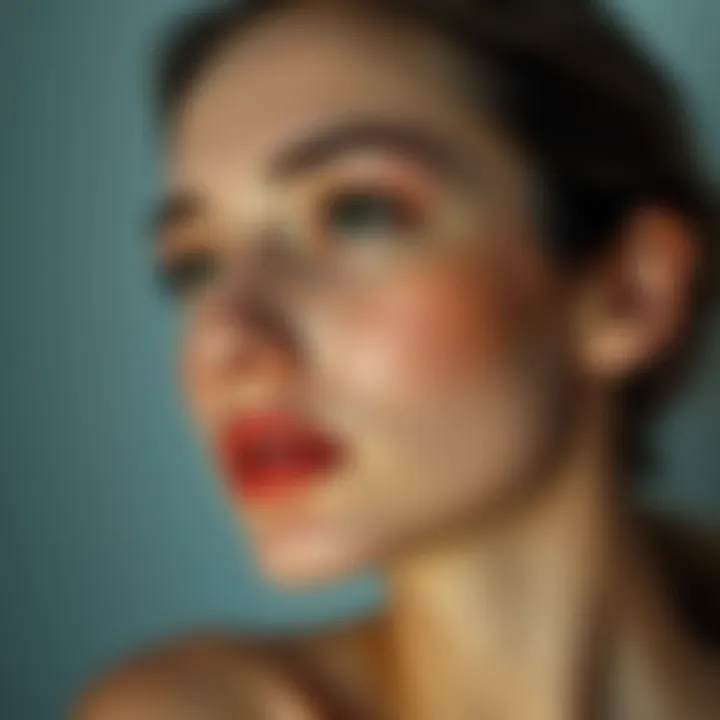Understanding Acne Clusters: Causes and Treatments


Intro
Acne can be a vexing issue, one that creeps up out of nowhere and seems to multiply in clusters like uninvited guests at a party. For many, this skin condition isn't just a physical battle; it carries a hefty emotional weight as well. Examining acne clusters involves peeling back the layers to understand what causes them, how they affect our psyche, and most importantly, what treatments can help clear the skin.
While some might dismiss acne as a teenage ailment, the truth is that it can affect individuals well into adulthood. Factors such as hormonal changes, stress, and even diet can play a significant role in the development of these agglomerations of pimples. Understanding this complexity is critical for effective management.
In this article, we’ll take a deep dive into the various causes of acne clusters, their impact on self-esteem and mental wellness, and an array of treatment options to empower those struggling with this condition. Whether you're a skincare novice or a seasoned expert, there's always something new to learn about your skin – and your journey to better skin health starts here.
Understanding Acne Clusters
Understanding acne clusters is vital for both experiencing individuals and medical professionals aiming to tackle this complex issue. Acne doesn't just affect the surface of the skin; it lies beneath, intertwined with hormonal changes, environmental influences, and psychological factors. Thus, recognizing acne clusters—those groups of pimples often appearing in certain areas—helps to identify the type and severity of acne, leading to tailored treatment options. With deeper insights into these clusters, individuals can adapt their skincare routines more effectively and respond to their skin's particular needs.
Defining Acne Clusters
Acne clusters refer to formations where multiple pimples appear in a concentrated area. Instead of isolated spots, a cluster may manifest as redness and inflammation on the cheeks, forehead, or chin. These clusters can indicate specific underlying problems, such as hormonal imbalances or skin irritation due to products. Identifying the presence of acne clusters can be the first step toward understanding a person's skin issues and finding appropriate remedies.
Types of Acne
Acne is not a one-size-fits-all experience; it comes in various forms, each with unique characteristics and implications for treatment.
Comedonal Acne
Comedonal acne includes non-inflammatory blockages in hair follicles, often appearing as small bumps on the skin. The key characteristic here is the formation of open or closed comedones—commonly known as blackheads and whiteheads, respectively. This type is less dramatic than others but serves as a foundational element that can lead to more severe forms of acne if left unchecked. Its inflammatory nature means the right treatment strategies can inhibit progression into serious issues, making it a critical focus in this exploration.
Inflammatory Acne
Inflammatory acne is marked by redness and swelling, arising when comedonal acne becomes irritated and infected. Papules and pustules emerge, distinguishing this type from its non-inflammatory counterpart. The specific aspect of inflammatory acne is its potential to lead to scarring if not effectively managed. In the context of this article, understanding inflammatory acne is crucial for developing strategies that not only address current outbreaks but also mitigate future occurrences, showcasing its role as a significant player in the acne spectrum.
Nodular Acne
Nodular acne is a more severe form that forms solid lumps under the skin, often painful to touch. The key characteristic of nodular acne is its depth, making it harder to treat than superficial types. This form can lead to significant scarring, emphasizing the need for prompt medical intervention. By shining a light on nodular acne, this article aims to stress the importance of recognizing systemic factors that contribute to its development, pushing awareness towards comprehensive treatment plans.
Cystic Acne
Cystic acne is known for causing painful, inflamed cysts that lie beneath the skin surface, often taking considerable time to heal. This type of acne results from the inflammation of sebaceous glands and is often resistant to over-the-counter treatments. The unique feature of cystic acne is its potential to cause scarring, establishing a layer of significance in managing and treating this serious issue. Highlighting cystic acne in the article helps in advocating for specialized care to prevent lasting damage and focuses on the importance of professional medical advice tailored to this severe form.
In summation, diving into the various types of acne emphasizes the necessity for education and awareness that goes beyond the surface. Each type carries its own pathophysiology and treatment implications, important for developing proactive management strategies. Understanding these nuances can empower those affected, leading to more effective self-care and lifestyle adjustments.
Causes of Acne Clusters
Understanding the causes of acne clusters is vital, as it forms the foundation of addressing this skin concern effectively. Recognizing what triggers these clusters can lead to tailored treatment plans and preventive strategies that are more effective. Hormonal changes, dietary habits, and environmental factors all intertwine in a complex way, significantly influencing the skin's health. The insights gained from exploring these causes not only enlighten individuals suffering from acne but also empower them to make informed lifestyle choices.
Hormonal Factors
Hormones play a crucial role in the formation of acne clusters. Fluctuations in hormonal levels can trigger an uptick in oil production in the sebaceous glands. This excess oil, in conjunction with dead skin cells, can lead to clogged pores. For women, menstrual cycles are particularly influential. During certain times of the month, normally stable hormone levels can spike or drop, igniting acne flare-ups. Additionally, androgens, commonly known as male hormones, can increase in both genders, further exacerbating oil production.
The connection between hormonal balance and skin clarity cannot be overstated; recognizing these cycles is key for effective management.
Dietary Influences
What you eat can have a say when it comes to acne clusters, and a clear connection between diet and skin health is increasingly well-documented. Some studies suggest that diets high in refined sugars or dairy products may worsen acne conditions. Foods that trigger insulin spikes can lead to inflammation, the driving force behind many skin issues.
Here’s a quick look at some dietary influences:
- High Glycemic Foods: These include white bread, pastries, and sugary drinks. They lead to elevated insulin levels, which can promote oil production.
- Dairy Products: Some people may find that milk and cheese in their diets correlate with an uptick in acne severity.
- Fatty Foods: Trans fats and fatty acids present in some fast foods can also affect skin health negatively.
On a positive note, consuming a balanced diet rich in antioxidants, vitamins, and healthy fats, found in fruits, vegetables, fish, and nuts, can support skin health and reduce acne formation.
Environmental Triggers
The environment in which one lives can greatly influence skin health as well. Factors such as pollution, humidity, and climate play a significant role in exacerbating acne conditions. For instance, high humidity levels can make skin feel greasier, clogs pores, and lead to clusters. Furthermore, pollutants in the air can lead to inflammation and irritation, making the skin more susceptible to breakouts.
Moreover, certain skincare and cosmetic products can act as irritants or allergens, provoking acne flare-ups. It's crucial to examine the labels and choose non-comedogenic (non-pore-clogging) products that won't exacerbate acne. In summary, staying aware of environmental conditions and making conscious decisions about product use can mitigate the risk of developing acne clusters.
Understanding how hormonal fluctuations, dietary choices, and environmental components contribute to acne clusters can open new avenues for effective management. With a rooted understanding of these triggers, individuals can make strides towards clearer skin and enhanced confidence.
Psychological Impacts of Acne Clusters
Understanding the psychological impacts of acne clusters is essential for anyone affected by this skin condition. Beyond the visible blemishes, acne can affect self-perception and emotional health significantly. When individuals face acne, especially in clusters, they might experience feelings of embarrassment, stress, or frustration. These emotions can spiral, influencing social interactions and even day-to-day choices. Educating readers on the psychological aspects aids in normalizing these feelings and underscores the importance of seeking support, making this topic ever relevant.
Self-Esteem Issues
Acne clusters can take a noticeable toll on an individual's self-esteem. Many people equate their appearance with their self-worth. Having visible acne can lead to feelings of inadequacy, often making individuals withdraw from social situations. Those who might typically engage freely can start second-guessing their looks, leading to avoidance of social events or even routines like meeting friends after work. A study mentioned on britannica.com illustrates that adolescents, as well as adults, attribute significant value to skin conditions when assessing self-image.
An important aspect to consider is that self-esteem issues can exacerbate the need for social validation. People may find themselves accumulating more makeup or seeking cosmetic procedures, not because they want to, but due to pressure they feel from society or peers.
"Sometimes we forget that our self-esteem should not rest on our skin's surface."
Understanding that this is a common experience may empower those affected, prompting them to confront their feelings with honesty. Talking openly about struggles with acne can often lighten burdens, creating a bond where individuals don’t feel isolated in their experiences.
Anxiety and Depression
Acne, particularly when clustered, often goes hand-in-hand with heightened anxiety and depression. The connection between psychological states and skin conditions is well-documented. Research has shown that many individuals with chronic acne battle persistent anxiety, often stemming from the fear of judgment due to their appearance. The worry about what others think can lead to a continuous cycle of stress, which may in turn worsen the skin condition itself.
Moreover, it is not uncommon for anxiety to manifest physically, leading to behaviors like picking at the skin. This action can further aggravate acne, creating an unhealthy, distressing loop. In fact, reddit.com hosts numerous discussions where individuals share their experiences about how acne clusters contribute to their anxiety levels, illuminating the often-overlooked emotional crises that accompany such a physical ailment.
Depression can also arise from prolonged exposure to skin issues. Studies highlight the impact of body image on mental health, demonstrating that individuals affected by acne clusters often report feelings of hopelessness and low mood. Knowing that they're not alone in this struggle may encourage them to seek help.
Medical Evaluation
Understanding the role of medical evaluation in the management of acne clusters is essential for those who seek comprehensive solutions for their skin concerns. The importance of consulting a professional cannot be understated; this process could mean the difference between an effective treatment strategy and a frustrating cycle of trial and error. Consulting a dermatologist can help in identifying the specific type of acne, its causes, and how best to tackle it. Dermatologists provide insights on the appropriate treatments based on individual skin types and conditions, optimizing the chances for successful outcomes.
When to See a Dermatologist


Recognizing when to seek the expertise of a dermatologist can be crucial. If over-the-counter products have not yielded satisfactory results within a few weeks, it may be time to consult a specialist. Additionally, signs such as worsening acne, persistent cysts, or scarring should prompt a visit. Individuals experiencing psychosocial issues due to their acne can also benefit from a professional assessment. A dermatologist can offer tailored treatment plans that address physical symptoms while also considering the emotional toll, making an appointment a wise choice for anyone struggling with acne clusters.
Diagnostic Procedures
In the dermatological evaluation of acne, specific diagnostic procedures assist in pinpointing the underlying issues. These may include:
Skin Examination
A thorough skin examination is often the first step in assessing acne clusters. During this procedure, the dermatologist evaluates the skin for various types of lesions, taking note of patterns and severity. The key characteristic of skin examinations is that they are non-invasive, making it a beneficial approach to understanding the individual’s skin health without causing additional discomfort.
Unique to this examination is its ability to reveal not only the surface-level characteristics but also subtle indications of underlying conditions. This sort of insight can significantly guide treatment choices that are most likely to be effective.
Allergy Testing
Allergy testing can uncover sensitivities that may exacerbate acne symptoms. By identifying allergens, dermatologists help patients eliminate triggers from their environments or diets. The main advantage of allergy testing lies in its capacity to offer personalized insights, allowing individuals to adjust their lifestyles accordingly. However, one drawback is that not all forms of acne are linked to allergies, so patients shouldn’t solely rely on it for an overarching solution to their acne issues.
Hormonal Testing
Hormonal testing plays a pivotal role, especially for individuals whose acne clusters are thought to be hormonally driven. This procedure examines hormone levels to find imbalances that could contribute to acne flare-ups. Its significance in managing acne clusters is especially profound for women since hormonal fluctuations often occur during menstrual cycles or with conditions like polycystic ovary syndrome (PCOS). While hormonal testing can yield useful information, it’s important to consider that results may not provide immediate solutions. Sometimes, adjustments in hormonal treatments can take time to manifest positive changes in the skin.
Overall, employing these diagnostic procedures enables a tailored approach to acne management, steering individuals toward effective treatment paths. With a combination of professional insights and precise testing, the journey to clearer skin can become a more targeted and hopeful endeavor.
Treatment Options for Acne Clusters
Understanding treatment options for acne clusters is paramount for anyone grappling with this skin condition. From topical solutions to procedural interventions, there’s a whole toolkit available to help manage, reduce, and even eliminate these bothersome breakouts. Each type of treatment has specific elements to consider, including effectiveness, convenience, and side effects. This section explores the most common treatments available, helping individuals choose the best course of action tailored to their needs.
Topical Treatments
Topical treatments are often the first line of defense for those dealing with acne clusters. They allow direct application to the skin, targeting the very source of the problem. Among these, three stand out: Benzoyl Peroxide, Salicylic Acid, and Retinoids.
Benzoyl Peroxide
Benzoyl peroxide is widely recognized for its ability to fight acne-causing bacteria. It works by introducing oxygen into the pores which helps in killing bacteria, reducing inflammation, and drying out excess oil. Its key characteristic is its potent antibacterial effect, making it a popular choice for treating mild to moderate acne.
One unique feature of benzoyl peroxide is that, while effective, it can sometimes irritate sensitive skin, leading to dryness or peeling. It’s crucial to start with lower concentrations to gauge tolerance.
Salicylic Acid
Salicylic acid is another well-respected ingredient found in many acne treatments. Renowned for its ability to penetrate pores and exfoliate from within, it helps to prevent clogging. The advantage of salicylic acid lies in its gentler nature compared to other treatments, making it a solid option for people with sensitive skin. However, users should still be aware of potential irritation when using higher concentrations.
Retinoids
Retinoids, derived from vitamin A, are effective for treating several forms of acne. They promote cell turnover, helping to prevent clogged pores and reduce inflammation. Their key characteristic is their ability to improve skin texture over time, making them a beneficial choice for those dealing with persistent acne, including clusters. A unique feature of retinoids is their progressive action; results can take time, often requiring consistent use for several weeks to months. Notably, retinoids may also cause initial dryness or irritation but are generally well-tolerated by many users.
Oral Medications
For those with more severe cases of acne or when topical treatments aren't enough, oral medications can be a game changer. The focus in this section is on antibiotics, hormonal treatments, and isotretinoin.
Antibiotics
Oral antibiotics help to reduce the bacteria on the skin, lowering inflammation and aiding in the overall treatment of acne. The key characteristic that makes antibiotics invaluable in acne treatment is their ability to tackle not just the outward symptoms but also the underlying infections. However, prolonged use may lead to antibiotic resistance, making medical guidance crucial.
Hormonal Treatments
Hormonal treatments can be particularly effective for women whose acne is influenced by menstrual cycles or hormonal fluctuations. These treatments aim to regulate hormones that may trigger acne production. The unique feature of hormonal treatments is that they target the root cause in some cases, which can yield lasting results. It's crucial to weigh the possible side effects, including mood changes or weight fluctuations.
Isotretinoin
Isotretinoin is often seen as a last resort for those with severe or resistant acne. Targeting the sebaceous glands, it dramatically reduces oil production and prevents new acne formations. Its key characteristic is its high efficacy in treating cystic acne and deeply clustered lesions. Despite its effectiveness, isotretinoin comes with a host of potential side effects, including severe dryness and the risk of birth defects if taken during pregnancy. Thus, careful monitoring by a healthcare provider is essential.
Procedural Interventions
When medications fall short, procedural interventions may provide the additional push needed towards clearer skin. This segment covers chemical peels, laser treatments, and extractive procedures.
Chemical Peels
Chemical peels involve exfoliating agents that remove the top layer of skin, helping to reduce acne scarring and improve overall skin texture. The key characteristic of chemical peels is their ability to enhance the skin’s appearance quickly. While they can be very effective, the recovery time can vary based on the type of peel applied, and post-care is vital to avoid complications.
Laser Treatments
Laser treatments help to address acne by targeting the oil glands without harming the skin's surface. This innovative approach is gaining traction for its effectiveness and minimal downtime. The unique feature of laser treatments is the targeted precision, and while results can be promising, multiple sessions are often necessary for optimal results.
Extractive Procedures
Extractive procedures involve the manual extraction of blackheads and whiteheads. While this can be effective in the short term for clearer skin, care must be taken; doing it improperly can lead to scarring. The advantage of these procedures is the immediate visible results, although they may not address the root causes of acne clusters.
In summary, treatment options for acne clusters span a wide range of choices, each with its own set of benefits and considerations.
By understanding what each treatment entails, individuals can better navigate their options and work towards healthier skin.
Preventative Measures
Preventing acne clusters is a multifaceted approach that covers various lifestyle changes and skin care practices. By understanding these preventative measures, individuals can take proactive steps to mitigate the risk of acne, fostering a sense of control over their skin health. Having a clear game plan is like having an umbrella on a cloudy day; it helps to put the odds in your favor against unexpected breakouts.
Daily Skincare Routine
A daily skincare routine lays the groundwork for healthy skin. Many people view skincare as an optional luxury, but it can be a crucial player in the fight against acne.
Cleansing
Cleansing is the first step in this routine and serves as a key aspect of skin hygiene. A proper cleansing regimen helps in removing dirt, oil, and impurities that clog pores.
The key characteristic of effective cleansing is its ability to balance the skin's natural oils while eliminating excess sebum. This balance is pivotal, especially for individuals prone to acne clusters. A popular choice here is a gentle cleanser that includes salicylic acid, which helps to exfoliate the skin and prevent clogging of pores.
However, it’s important to note that over-cleansing can lead to dryness and irritation, exacerbating the problem rather than solving it. Therefore, knowing your skin type and selecting the right product is essential for maximizing benefits while minimizing risks.


Moisturizing
Moisturizing is the next vital step in the skincare hierarchy. Many mistakenly believe that using a moisturizer will lead to more oil and, consequently, more acne. In truth, moisturizing is about keeping the skin hydrated and preventing it from overproducing oil in response to dryness.
The key characteristic here is that a good moisturizer should be non-comedogenic, meaning it won’t clog pores. A gel-based moisturizer works well for oily or combination skin types, while cream-based options fit those with dry skin. The unique feature of moisturizing is its dual role; it hydrates and creates a protective barrier against environmental aggressors. Inadequate moisturizing can lead to compromised skin barriers, making acne more likely.
Sunscreen Usage
Sunscreen usage becomes crucial when discussing preventative measures. Protecting the skin from sun damage helps to prevent post-inflammatory hyperpigmentation (dark spots) that can occur after acne heals. Using a sunscreen with at least SPF 30 is recommended for effective protection.
The key characteristic of an appropriate sunscreen for acne-prone skin is its non-comedogenic formula. A physical sunscreen containing zinc oxide or titanium dioxide is often favored, as it provides a broad spectrum of protection while being gentle on the skin. One significant advantage of regular sunscreen application is that it lowers the risk of developing skin cancer down the line. However, some sunscreens might leave a greasy residue, which can be counterproductive for acne-suffering individuals.
Lifestyle Changes
Making positive lifestyle changes can further enhance the prevention of acne clusters. These changes might be as simple as adjusting diet or managing stress.
Healthy Diet
The significance of a healthy diet extends beyond just physical well-being; it profoundly impacts skin health as well. Including foods rich in antioxidants, such as fruits and vegetables, can help in reducing inflammation and improving skin conditions.
The key characteristic of a skin-friendly diet is its emphasis on low glycemic index foods, as high sugar levels can aggravate acne. Foods like whole grains, legumes, and nuts can aid in maintaining stable blood sugar levels. The unique feature of a balanced diet lies in its potential to reduce the occurrence of hormonal spikes, which often contribute to acne flare-ups. However, dietary changes take time to show results and might require a bit of perseverance.
Stress Management
Stress management plays an intricate role in acne prevention. Stress triggers hormone releases that may lead to increased oil production, so managing one’s stress levels can mitigate this process. Techniques such as mindfulness or even yoga can serve as effective means for stress reduction.
The key characteristic is that incorporating stress reduction strategies into daily life can lead to a more balanced emotional state, which is beneficial not just for mental health but also for skin health. The unique feature about stress management is that it often requires consistent practice but can yield significant lifelong benefits.
Regular Exercise
Regular exercise contributes not just to physical fitness but also to skin vitality. Engaging in physical activity enhances blood circulation, which can promote healthier skin. Moreover, sweating allows the body to expel toxins that often contribute to skin irritations.
The key characteristic of regular exercise is its ability to balance hormones and reduce stress, both of which are essential factors in the regulation of acne. While exercise has numerous benefits, it's crucial to ensure that one cleanses the skin thoroughly post-workout to prevent any sweat-related breakouts. However, not all workouts are suitable for everyone; some may find that certain exercises exacerbate their skin issues.
Myths About Acne Clusters
Understanding the common myths about acne clusters is crucial for anyone navigating the complexities of skin health. Misconceptions can lead to ineffective treatments and inadequate care strategies. This section aims to debunk these myths with a detailed examination, leading to better awareness and management of acne. The greater the understanding, the more empowered individuals feel in tackling their skin issues.
Myth: Acne is only a teenage issue
This particular myth often lingers like an unwelcome guest at a party. While it’s true that many teenagers experience acne due to hormonal changes during puberty, this condition doesn't magically disappear after the teen years. Many adults find themselves dealing with acne clusters well into their thirties and even beyond.
The truth is, hormonal fluctuations, stress, and lifestyle factors can all contribute to acne at any age. Women, in particular, might encounter outbreaks tied to their menstrual cycle, pregnancy, or menopause. According to studies, about 50% of women in their 20s and 30s report persistent acne. This statistic underscores that acne is far removed from a teenage-only affliction.
Understanding this myth is paramount. It encourages adults to seek appropriate treatment instead of dismissing their skin concerns as temporary or insignificant. Just because someone has reached adulthood doesn’t mean their skincare journey is finished; in fact, it could just be beginning.
Myth: Diet has no impact on acne
There is a widespread belief that what one eats has no bearing on their skin health. Yet, recent research highlights a strong connection between diet and acne development. Certain foods, particularly those high in refined sugars and dairy, have been linked to increased acne severity. Some individuals find that eliminating dairy products or avoiding high glycemic index foods helps improve their skin condition.
Moreover, foods rich in antioxidants, such as fruits and vegetables, can help combat inflammation. A well-balanced diet supports overall skin health, suggesting that nutrition can be a crucial element in acne management. This awareness can also lead to deeper reflections about lifestyle choices and personal well-being, allowing individuals to take control of their skincare routines.
Myth: Tanning clears up acne
This myth may seem appealing at first glance, especially with the allure of sun-kissed skin. Some people believe that exposing their skin to sun can help clear up acne. However, while a tan may temporarily mask the appearance of blemishes, sun exposure can actually exacerbate acne issues and create more long-term problems.
The ultraviolet rays can cause skin to become damaged, leading to increased inflammation and irritation in acne-prone individuals. Furthermore, tanning does not eliminate the underlying issues causing the acne, thus making it merely a cosmetic solution without a real effect on the skin's health.
Beyond the immediate effects on acne, excessive sun exposure raises the risk of skin cancers and premature aging. Educating oneself about the dangers of unprotected tanning can be a game changer in determining the best course of action for treating acne while prioritizing skin health.
In summary, understanding these myths about acne clusters helps individuals make informed choices about their skin care routines. By busting these misconceptions, people can pave the way to healthier skin and more effective treatment strategies.
The Role of Genetics in Acne Clusters
Understanding the role of genetics in acne clusters is like peeling an onion—layer after layer exposes deeper insights into this complex condition. It's crucial to recognize that not all skin issues arise solely from environmental factors or skincare habits. Our genes can be powerful players, influencing not just the likelihood of developing acne but also its severity. By exploring this facet of acne, we give ourselves a fighting chance to both predict and manage outbreaks more effectively.
Family History and Acne
Unearthing the familial connections linked with acne offers an enlightening perspective. Research suggests that if you have family members who have grappled with persistent acne, your chances of developing similar issues rise significantly. This inheritable tendency can often feel like a shadow that follows from parent to child, manifesting in clusters of pimples during stressful times or hormonal shifts.
Consider your family as the root of your skin’s fate. When parents exhibit acne, they may pass down specific skin characteristics or tendencies toward inflammation and oil production. These inherited traits can predispose individuals to similar skin issues like cystic acne or nodular formations. For instance, if both your mother and father struggled with acne, the odds are stacked against you. This isn't to say you're doomed to a life of skin struggles, but recognizing the pattern can be pivotal in determining your skincare regimen and lifestyle habits to combat it effectively.
Hereditary Skin Conditions
In some cases, the genetics reading isn’t limited to just acne as an isolated issue. A whole host of hereditary skin conditions can contribute to or exacerbate acne clusters. Conditions like polycystic ovary syndrome (PCOS) come to mind, which can be tied to hormonal imbalances and often lead to acne flare-ups.
Skin conditions like eczema or psoriasis can also exhibit overlaps with acne. When the skin barrier is compromised due to these conditions, it might trigger the appearance of acne, especially around inflamed patches. This interplay between genetics and skin health can create a complex narrative that makes managing acne even more challenging.
To sum it up, genetics plays a significant role in predisposing individuals to acne clusters.
"Understanding your family's skin history not only assists in predicting your own skin issues but can also inform the best approaches to treatment."
By delving into potential hereditary traits and skin conditions, individuals can tailor their skincare strategies while working with dermatologists. Ultimately, genetics is just one piece of the acne puzzle; however, it’s a piece that should not be overlooked.
As ongoing research uncovers more about our genes, incorporating this wisdom into our skincare routines becomes even more important, allowing us to navigate the tumultuous waters of acne clusters with knowledge and awareness.
Understanding Acne Scars
Understanding acne scars is pivotal as they are often a lingering reminder of a skin condition that many find distressing. Acne, especially in its more severe forms, can leave behind a variety of scars that affect both appearance and self-image. It’s essential to differentiate between the types of scars so one can approach treatment effectively. Moreover, recognizing how scars form helps in understanding the healing process and what actions can be taken to minimize their appearance.
The psychological impact of these scars can be profound. For many, they serve as constant reminders of a battle once fought against acne, resulting in self-esteem issues. Knowing the types of scarring can empower individuals to seek the right solutions and, as a result, improve mental well-being. Let's delve deeper into the various forms of acne scars and their distinct characteristics.
Types of Scarring
Acne scars come in varying types, each with its specific characteristics and implications for treatment.


Ice Pick Scars
Ice pick scars are narrow, deep scars that resemble a small puncture wound. They are often the result of severe acne and are challenging to treat because of their depth. The key characteristic that sets ice pick scars apart is their pointed, V-shaped appearance, which gives them a unique profile that requires specialized care.
One beneficial aspect of recognizing ice pick scars in this discussion is their prevalence. Addressing these scars effectively can significantly enhance one’s skin texture and boost confidence. However, the challenge lies in the fact that they often require more invasive procedures such as punch excisions or laser treatments, which may not be readily accessible for everyone.
Boxcar Scars
Boxcar scars are broader scars with sharply defined edges, making them resemble small boxes on the skin. These scars are typically more superficial than ice pick scars, though they can still be quite prominent. The key characteristic here is that they often have a wider base and can give the skin a somewhat uneven texture.
Their treatment options can be more varied than those for ice pick scars, including fillers and microneedling, which are less invasive. This flexibility can make boxcar scars an appealing focus in discussions about acne scarring, due to the availability of multiple approaches to management.
Hypertrophic Scars
Hypertrophic scars are raised scars that develop when the skin produces too much collagen during the healing process. They form thicker than the surrounding skin and can sometimes be itchy or painful. These scars tend to be red or darker in color, which can make them more noticeable. The key characteristic of hypertrophic scars is their texture, which can feel bumpy to the touch.
Understanding hypertrophic scars is beneficial as they respond well to various treatments like silicone gel sheets and steroid injections, allowing for effective management. Furthermore, their tendency to fade and become less pronounced over time offers a degree of hope for those affected.
Treatment of Acne Scars
When it comes to treating acne scars, a one-size-fits-all solution simply doesn’t exist. Each type of scar responds differently to various treatments. Here, we touch upon effective treatments that can help minimize the appearance of the scars discussed.
- Laser Treatments: Technologies such as fractional laser therapy can target specific scar types, promoting skin renewal while minimizing damage to surrounding tissues.
- Chemical Peels: These can help improve the skin texture, particularly for boxcar and some hypertrophic scars, by removing the outer layer of damaged skin.
- Dermal Fillers: Particularly useful for boxcar scars, they add volume and can create a smoother appearance.
- Microneedling: Helps to stimulate collagen production, offering benefits across various scar types.
- Surgical Options: For ice pick scars, techniques such as punch excision can yield significant improvements.
In summary, understanding the variety of acne scars empowers individuals to identify the most appropriate treatment options. By acknowledging the differences, one can embark on a journey toward better skin health, ultimately aiding in the healing of both the skin and the self.
Long-Term Management of Acne Clusters
Long-term management of acne clusters plays a pivotal role in not just clearing up the skin but also in maintaining a healthy emotional balance and improving confidence. Those dealing with these skin conditions know that a bit of a breakout can undermine self-image, especially given society's focus on flawless skin. Tackling acne clusters isn’t just about the immediate fix; it’s about creating sustainable practices that keep skin healthy over time.
An effective long-term management strategy involves commitment and understanding. Individuals need to tailor their treatments to their unique skin type and the specific characteristics of their acne. Everyone's skin behaves differently under various conditions, thus personalization of ongoing plans is vital. A consistent approach allows for better monitoring of how skin responds, enabling adjustments to be made without significant delays.
Key Elements of Long-Term Management:
- Consistency: Regular application of prescribed treatments, whether topical or oral, is essential for preventing new breakouts.
- Adaptability: Skin conditions can change due to various factors, so being open to modifying treatment approaches is crucial.
- Assessment: Continually assessing how treatments are working helps in acknowledging successes and recognizing when something may not be effective.
For instance, hormonal acne might require a different approach than cystic acne. With hormonal treatments like spironolactone or the use of hormonal birth control, monitoring progress and side effects becomes even more crucial. Similarly, someone utilizing topical retinoids should check for skin irritation or dryness and adjust frequency or concentration as needed.
The benefits of a well-crafted long-term management plan go beyond just clear skin. Improved skin health often correlates with enhanced self-esteem and lower anxiety levels. As skin improves, individuals may find it easier to engage in social situations, further improving their psychological well-being. A proactive approach can turn the tide against persistent skin issues, leading to a more fulfilling life.
Ongoing Treatment Plans
Ongoing treatment plans serve as the backbone of effective long-term management, providing structure and a clear path forward. These plans can differ greatly depending on the individual's skincare needs and specific acne types. It’s not a one-size-fits-all scenario; consider the variances in genetic predisposition, lifestyle, and environmental influences.
- Regular Dermatologist Visits: Scheduling check-ups every few months to reassess treatment effectiveness and make adjustments is fundamental. This ensures that treatments are still aligned with what’s happening on one's skin.
- Combination Therapies: Many find success in combining treatments, such as using topical treatments alongside oral medications. For example, benzoyl peroxide can be effective in tandem with antibiotics or hormonal treatments.
- Educative Resources: Staying informed through articles, forums, and relating with others who have similar experiences can also contribute to better decision-making.
Also, one might find value in tracking progress through a journal, documenting breakouts, product use, and emotional responses. This can guide future choices and adaptations in treatment strategies.
Monitoring for Recurrence
Monitoring for recurrence is a crucial aspect of long-term management that often gets overlooked. Acne clusters can be a relentless challenge, and after every clear up, the fear of recurrence looms large. Understanding triggers and how to deal with them efficiently is key to maintaining clear skin.
- Keep a Trigger Diary: Use a diary to jot down flare-ups, noting any dietary changes, stress levels, or new products that may have contributed.
- Routine Reevaluation: Regularly revisit the plan and change it if new patterns emerge. Some individuals may start to notice that certain foods or stressors line up with bouts of acne, triggering the need for changes in both diet and lifestyle.
- Emotional Monitoring: Acknowledge that psychological stress can play a huge role in skin health. Methods like mindfulness and relaxation can have unexpected benefits for one's skin.
A quote from dermatologist Dr. Whitney Bowe sums it up well: > "The skin is a reflection of our internal health, both physically and emotionally."
Improving skin health is a journey requiring patience and strategy. The dedication to understanding and managing acne clusters can yield significant improvements in both appearance and overall quality of life. The integration of reflection, awareness, and adaptability forms the cornerstone of successful long-term management.
Support Resources
Support resources play a pivotal role in the journey of managing acne clusters, which can often feel like an uphill battle. While medical treatments and skincare regimens are essential, the psychological and emotional aspects of dealing with skin issues should not be overlooked. Support resources offer a sense of community, understanding, and guidance, which can significantly enhance one’s overall treatment experience.
Support Groups
Support groups provide a safe space for individuals grappling with the complexities of acne clusters. These groups often consist of people who share similar experiences and challenges, allowing participants to express their feelings and thoughts without judgment. Benefits of joining support groups include:
- Empathy and Understanding: Members often relate to each other’s struggles, which reduces feelings of isolation and loneliness.
- Sharing Experiences: Hearing others’ stories can provide fresh perspectives on managing acne. Someone might suggest a product or strategy that worked for them, giving fellow members new hope.
- Emotional Support: It’s comforting to know that others are on a similar path, creating a strong support network.
- Information Exchange: Members might discuss recent studies, personal routines, and coping mechanisms, helping each other navigate their treatment options more effectively.
These groups can be found in person at local community centers or online. Websites like Facebook and Reddit host a variety of groups dedicated to skincare and acne support. Connecting with others who understand the psychological toll of acne can empower individuals to take charge of their skin health.
Online Communities
The digital age has opened doors to numerous online communities focused on skin health. These platforms allow individuals to interact, share, and learn from a global audience. Online communities can be invaluable for several reasons:
- Access to Diverse Perspectives: Users from different backgrounds may share various coping strategies, revealing how cultural differences can influence skincare approaches.
- Real-Time Discussions: Forums and social media platforms enable members to pose immediate questions and receive instant feedback from experienced users or professionals.
- Educational Content: Many online platforms offer articles, tutorials, and webinars about acne causes, treatments, and health tips, which can deepen understanding of the condition.
- Anonymity and Comfort: For those hesitant about discussing their skin issues in person, online communities provide a veil of anonymity, making it easier to voice concerns and seek advice.
Resources such as Wikipedia and Britannica offer factual information about acne, while community forums can provide personal insights and emotional support. Engaging with these digital spaces might inspire individuals to adopt healthier skincare habits, helping them feel more in control of their acne journey.
In summary, embracing support resources—whether through local groups or online communities—enhances the ability to cope with and manage acne clusters. They not only equip individuals with practical advice but also help foster a sense of belonging that is crucial in addressing the emotional facets of skincare.
Emerging Research on Acne Clusters
The study of acne clusters is becoming increasingly relevant in dermatology. Emerging research aims to unravel the complexities of this skin condition, its causes, effects, and the most effective treatments available. This section highlights the significance of recent findings while also pointing toward potential future advancements in the management of acne.
Recent Studies
New studies within dermatological research are shedding light on various aspects of acne clusters. Some noteworthy findings include:
- Inflammatory Responses: Researchers have been investigating the role of inflammatory markers in the skin. Elevated levels of specific cytokines have been correlated with more severe cases of acne clusters. This insight could lead to targeted treatments that reduce inflammation specifically.
- Gut-Skin Connection: It's turning out that the microbiome may hold keys to understanding acne. Certain studies suggest that an imbalance in gut bacteria can influence skin health. By addressing gut health, patients might see improvements in their acne condition.
- Personalized Medicine: Recent clinical trials have begun exploring how genetic factors can inform treatment decisions. Drugs tailored specifically to a patient’s genetic makeup may offer more effective and safer options for managing acne clusters.
These ongoing investigations provide a glimmer of hope for individuals struggling with persistent acne, suggesting a shift from generic treatments to more precise, personalized approaches.
"The future of acne treatment lies in understanding the individual's biological profile, making therapies more effective and tailored."
Future Directions
Looking ahead, the research community envisions several exciting directions in the field of acne treatment research. Potential avenues include:
- Novel Therapeutics: New medications targeting the underlying biological mechanisms of acne formation are on the horizon. For instance, biologics, which are already utilized in treating other skin disorders, may be evaluated for their efficacy against acne clusters.
- Advanced Diagnostic Tools: With technological advancements, there's promise for non-invasive diagnostic methods that can determine an individual's skin condition. By leveraging AI and skin imaging technologies, dermatologists may soon be able to personalize treatment plans more effectively.
- Holistic Approaches: Future research will likely prioritize holistic treatment strategies combining diet, stress management, and skincare tailored to an individual's unique lifestyle and skin type. This holistic integration can help address acne not just from a topical or pharmaceutical angle but from a lifestyle perspective.
- Longitudinal Studies: Further long-term studies are required to understand acne's progression and the impact of various treatments over time. Monitoring patients over longer periods will provide invaluable data on the durability and effectiveness of treatments.
The exploration of these future directions in acne research demonstrates a commitment to understanding and addressing the multifaceted nature of acne clusters. By staying abreast of these advancements, both physicians and patients can engage in informed discussions about the best pathways to clearer skin.







